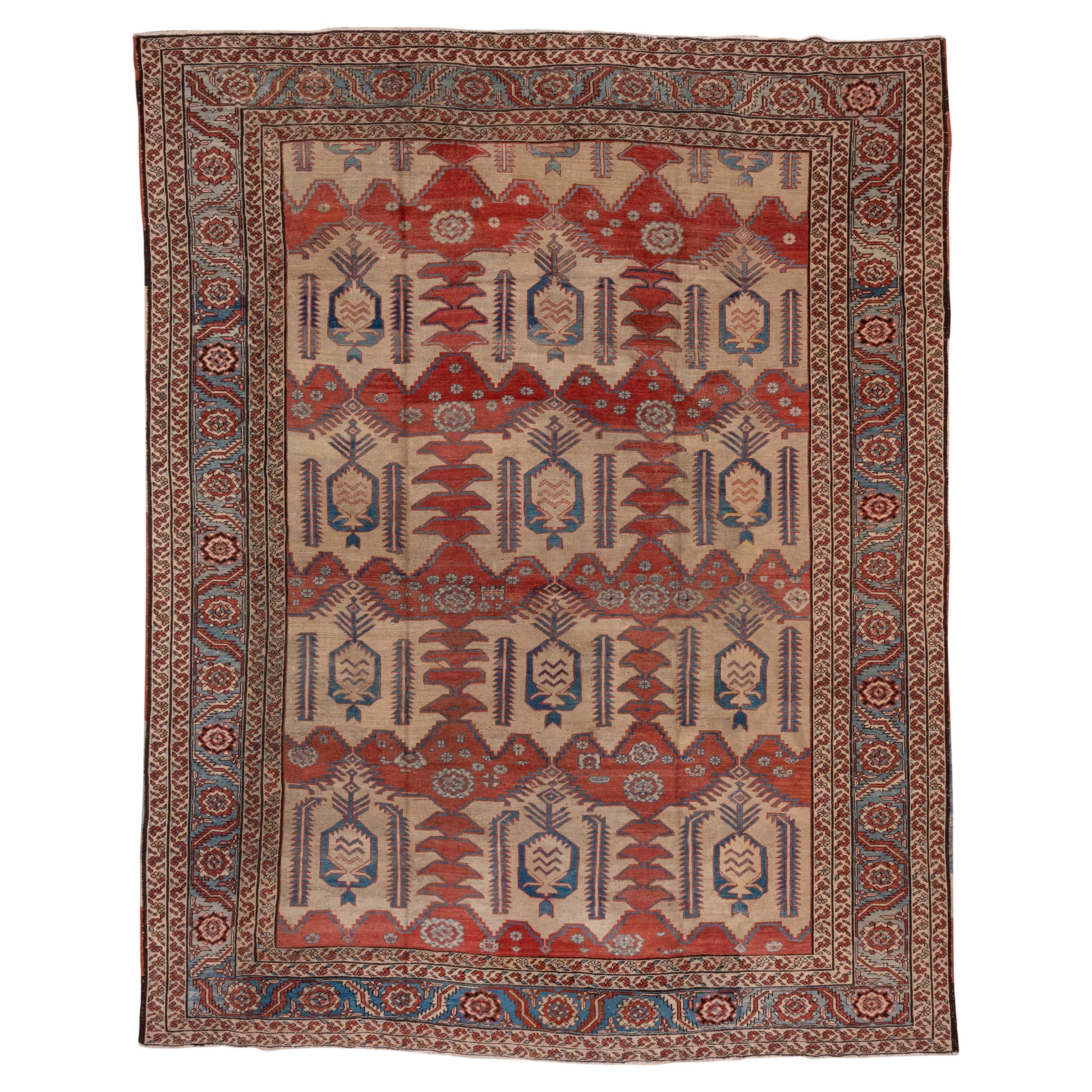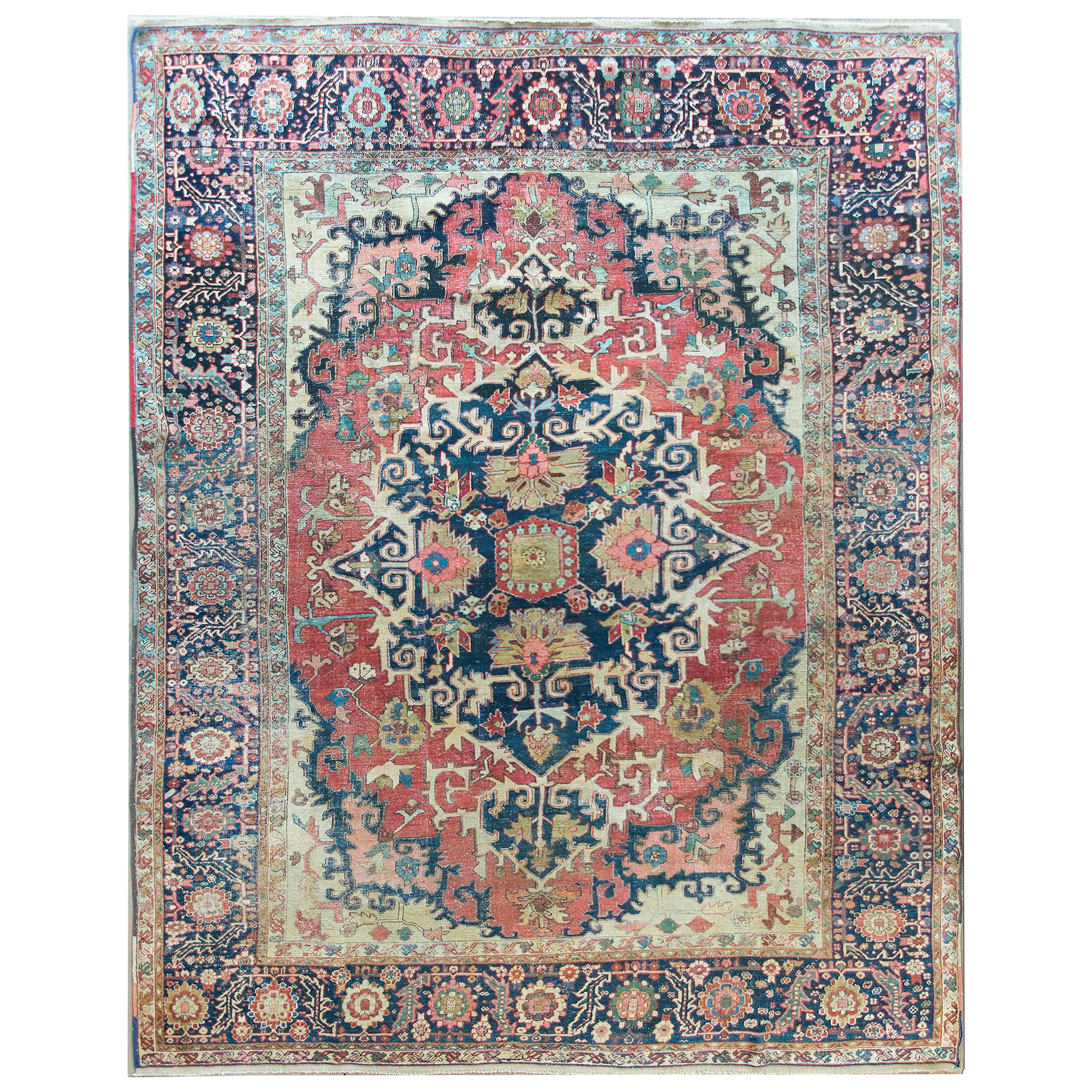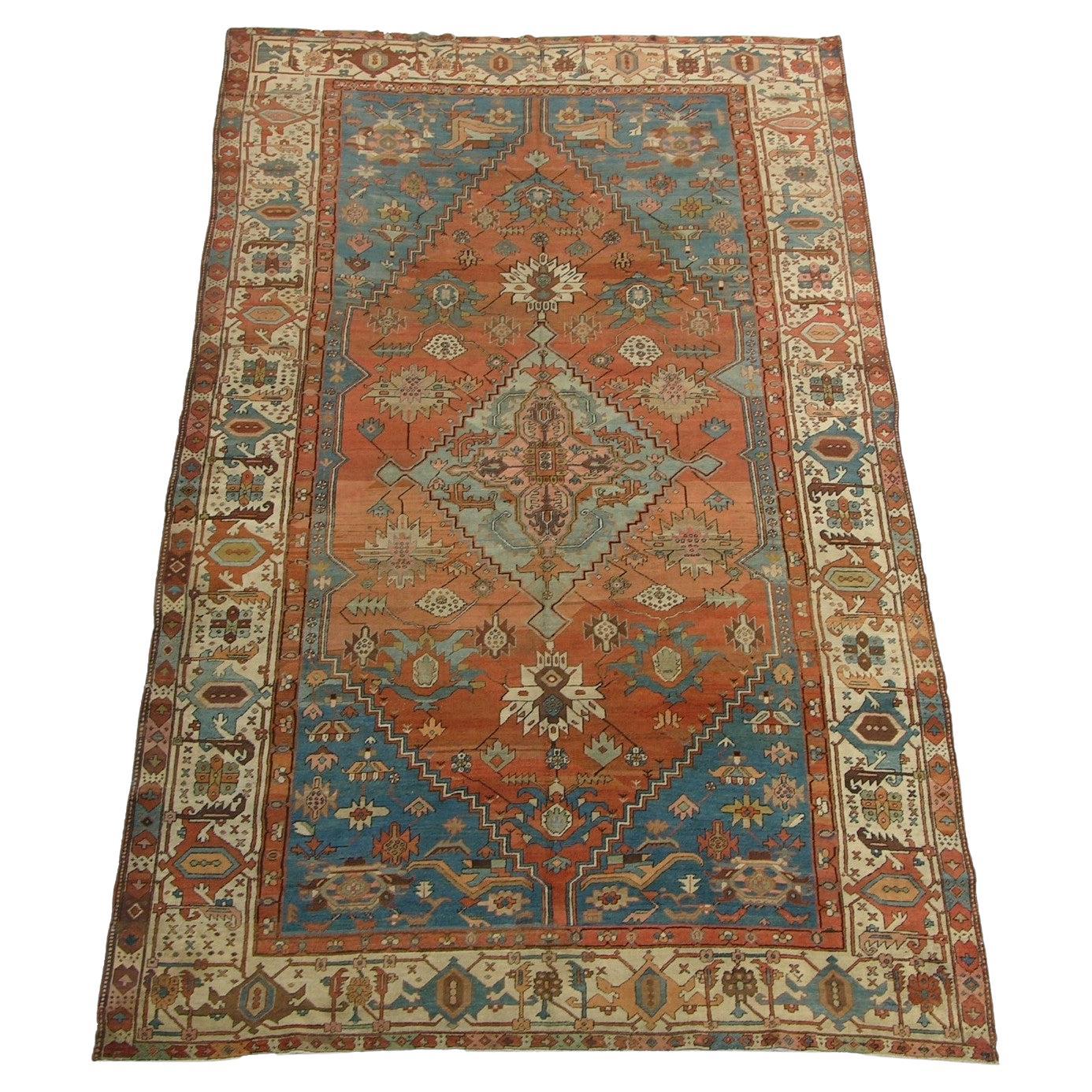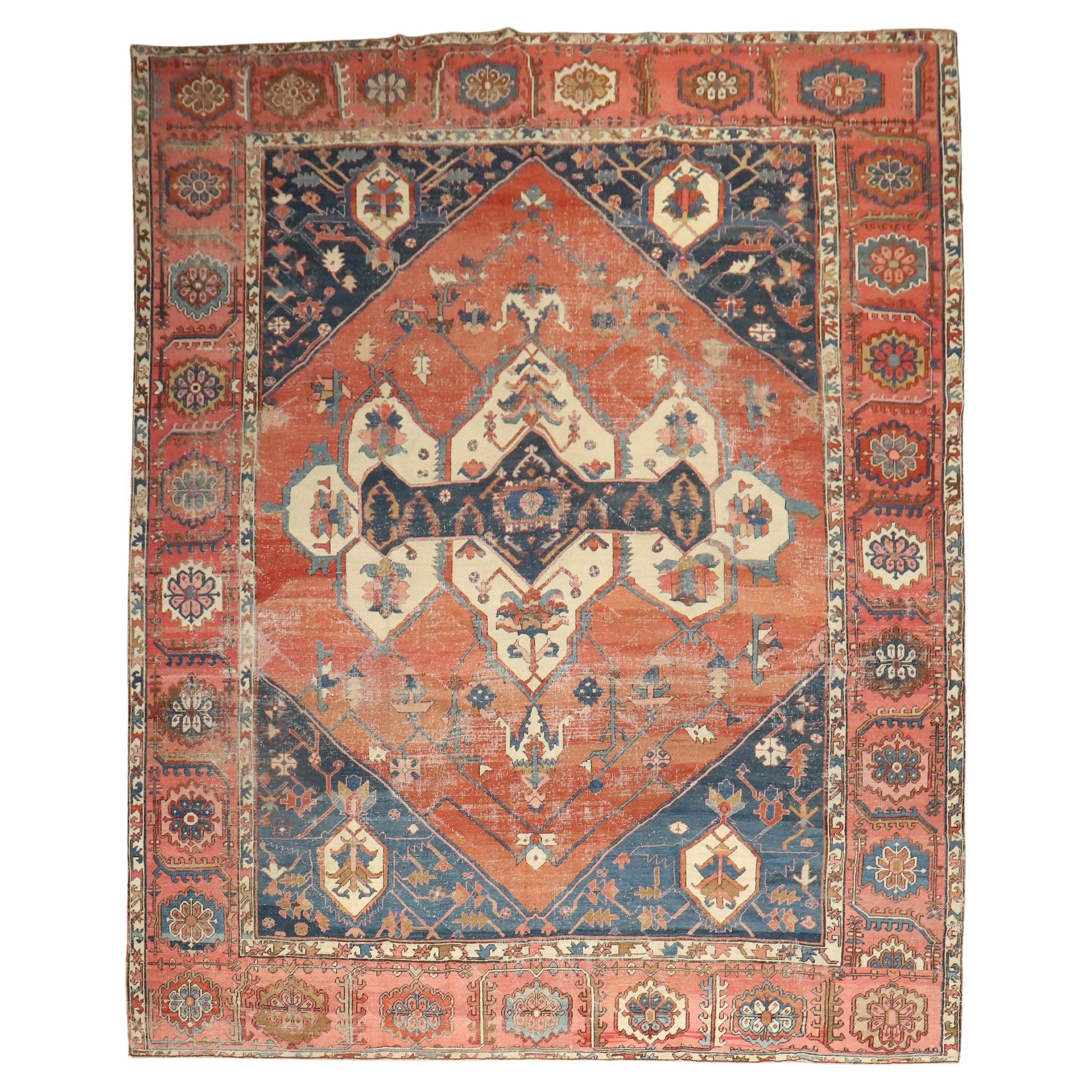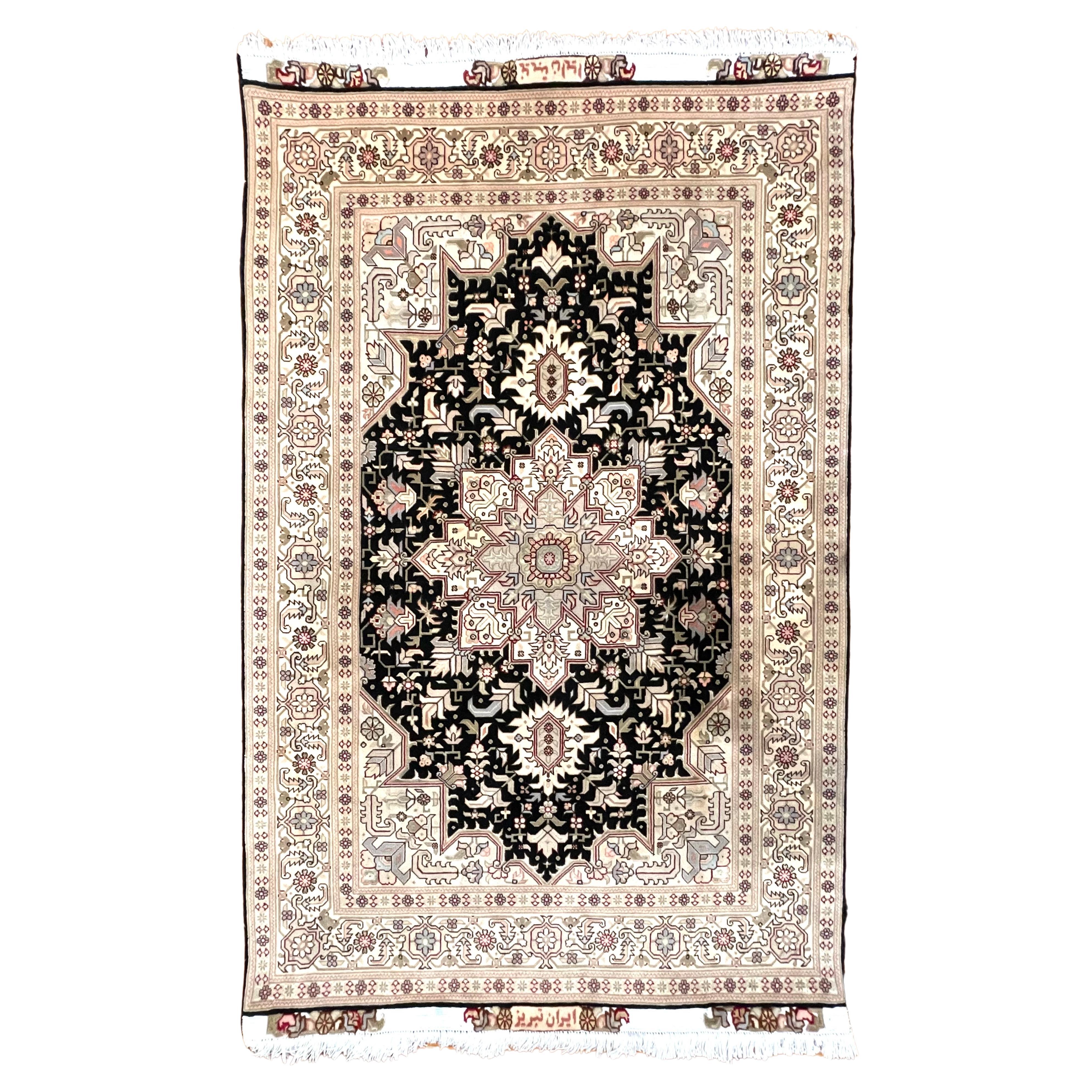Items Similar to 19th Century Geometric Tribal Serapi Heriz Tabriz Rug
Want more images or videos?
Request additional images or videos from the seller
1 of 5
19th Century Geometric Tribal Serapi Heriz Tabriz Rug
About the Item
The village of Heriz is located just east of Tabriz in the Persian occupied part of Azerbaijan. Heriz carpets are mostly distinguished by their rectilinear designs, a departure from the traditional arabesques and scrolls typical of Persian manufactory.
A large central stepped medallion with corners or an all over design of highly stylized floral motifs is quite typical. Repeating patterns are less common. The pile is thick and heavy and the color palette is rich and varied. Older Heriz rugs had madder grounds and medallions mostly of indigo. The finer rugs use the technique “double outlining”, where the design of the rug is separated from the field by two lines in different colors. This design element sets the gold standard for the best Heriz designs.
Originating in Northwest Persia and the Iranian province of East Azerbaijan, Heriz Oriental rugs from Persia include regional patterns created in several dozen towns and villages in the area. These Azeri-Turkish groups from the Caucasus were pushed south by invading Russian and Soviet forces, and the area was subject to turbulent political influences that continued through the 20th century. Turkic nomads have produced fine carpets for export and resale since the 1700’s, and antique Heriz rugs continue to enjoy great popularity in Europe and the U.S. The Heriz moniker is applied to regional rugs originating in Ahar, Gorevan and several other prominent villages. This has lead to some confusion about these trade terms.
The city of Heriz is located roughly 60 miles from the legendary carpet-producing city of Tabriz. Although they are closely related in some respects, their styles remain distinct. Antique Heriz rugs are known for their thick, strong and durable structure. Unlike many areas of Persia, rugs from Heriz are made with the symmetric Turkish or Ghiordes knot, which is attached to a specially woven foundation that includes a thick cotton warp and weft. The structure is only one factor that contributes to the durability and stability of antique rugs from Heriz, which differ from their cousins, the Serapi Rugs and the Bakshaish rugs. Further, some carpets from this region are referred to as Heriz Serapi rugs. Tucked into the foothills surrounding the historically active volcano Mount Sabalan, Heriz sits on top of rich mineral reserves and some of the largest copper deposits in the world. Pastoral nomads known as the Shahsavan migrated across the area moving closer to Mount Sabalan in the summer and further away during the harsh winters. The result is extremely durable wool containing trace amounts of copper that act as a natural mordant and dye fixative.
Since the early 19th century, Heriz has been producing European-sized carpets that define the angular style of northwest Persian rugs. These classically colored carpets, including Serapi Heriz rugs, often feature a traditional pairing of crimson red and clear Persian blue, which are combined with varied neutrals. Heriz rugs often feature dense allover patterns and angular octofoil medallions surrounded by rectilinear vine-scrolls decorated with a rich variety of contrasting colors.
Please note, the terms Heriz and Serapi are pretty much interchangeable. Heriz rugs are among the most recognizable Persian rugs because of their distinctive geometric designs and the expressive power of their drawing.
Both the “Serapi” and Heriz rugs tend to have strong medallion designs accented through the use of color. That said, allover design Heriz rugs are not that uncommon. Heriz carpets rely on floral inspired patterns with sharp strap-work vines and grand palmettes with zig-zag contouring.
Where other antique rugs from Persia would utilize a curved form, antique Heriz rugs will apply series of angular twists and sharp straight angle turns, imparting an emphatic geometry to the rug design.
Heriz rugs have glorious color, with rich reds, blues, greens, and yellows resonating against ivory. Much of the formal vocabulary, drawing, and color sensibility of these rugs is traceable to the classical antique Caucasian rugs of the eighteenth and seventeenth centuries.
Since the Heriz region of northern Perisa is not far from the Caucasus, it is not surprising that Heriz carpets have preserved so much of the classical Caucasian tradition. Some antique Heriz rugs , however, especially those produced in silk, display a different drawing and design vocabulary linked to other types of Persian carpet. They are identified as “Heriz” rugs primarily by their weave.
Just west of Tabriz lies the village of Heriz, located in the Iranian part of Azerbaijan. Herizes are mostly distinguished by their rectilinear designs, a departure from the traditional arabesques and scrolls typical of Persian manufactory. A large central stepped medallion with corners or an allover design of highly stylized floral motifs is quite typical. Repeating patterns are less common.
The pile is thick and heavy and the color palette is rich and varied. Older Heriz rugs had madder grounds and medallions mostly of indigo. The finer antique carpets use the technique “double outlining”, where the design of the rug is separated from the field by two lines in different colors. This design element sets the gold standard for the best Heriz designs.
The Heriz style of is a paradigm for the traditional geometric designs of Northwest Persia. These distinctive rugs are woven with tribal weaves which accentuates the angles and boldness exhibited in the highly stylized floral motifs.
Typically these traditional Oriental area rugs carry a masculine aura to them. As far as interior design goes, this feature makes them perfect options for libraries, studies, and other rooms rich with wooden or earthy accents though they are also popular in living rooms both formal and non.
- Dimensions:Width: 106 in (269.24 cm)Length: 171 in (434.34 cm)
- Style:Tabriz (In the Style Of)
- Materials and Techniques:
- Place of Origin:
- Period:
- Date of Manufacture:1900s
- Condition:Wear consistent with age and use.
- Seller Location:Los Angeles, US
- Reference Number:
About the Seller
5.0
Gold Seller
These expertly vetted sellers are highly rated and consistently exceed customer expectations.
Established in 1920
1stDibs seller since 2023
26 sales on 1stDibs
Typical response time: <1 hour
- ShippingRetrieving quote...Ships From: Los Angeles, US
- Return PolicyA return for this item may be initiated within 3 days of delivery.
More From This SellerView All
- Late-19th Century Persian Heriz Serapi CarpetLocated in Los Angeles, USAntique Heriz Carpets Serapi Rugs and Persian Bakshaish Carpets – The carpets of northwest Persia are in a class of their own. Prized for their strong geometric style, fine construct...Category
Antique 1880s Persian Tabriz Persian Rugs
MaterialsWool, Cotton
- late-19th Century Authentic Tribal Persian Tabriz CarpetLocated in Los Angeles, USAntique Tabriz rugs are distinguished by their excellent weave and by their remarkable adherence to the classical traditions of antique Persian rug design. But they cannot be disting...Category
Antique Late 19th Century Persian Tabriz Persian Rugs
MaterialsWool, Cotton
- Mid-19th Century Persian Tabriz CarpetLocated in Los Angeles, USAntique Tabriz rugs are distinguished by their excellent weave and by their remarkable adherence to the classical traditions of antique Persian rug design. But they cannot be disting...Category
Antique Mid-19th Century Persian Tabriz Persian Rugs
MaterialsWool, Cotton
- Antique Tabriz Floral Design Rug 12'5''x9'7''Located in Los Angeles, USAntique Tabriz Stylish Floral Design 12'5''x9'7''Category
Antique Early 1900s Unknown Tabriz Persian Rugs
MaterialsWool, Cotton
- 19th Century Tribal Karabagh RugLocated in Los Angeles, USAntique Karabagh rugs Eagerly sought after by collectors as well as designers, have one of the oldest and most varied design traditions of any antique Caucasian rugs. Many are descen...Category
Antique 19th Century Azerbaijani Other Turkish Rugs
MaterialsWool, Cotton
- 19th Century Tribal Caucasian RugLocated in Los Angeles, USThe antique Caucasian rugs get their name from the area in which they were made – the Caucasus. The Caucasus is a region that produces distinctive rugs since the end of the 18th cent...Category
Antique 19th Century Other Russian and Scandinavian Rugs
MaterialsWool
You May Also Like
- Late 19th Century Tribal Antique Heriz Serapi CarpetLocated in New York, NYThis unusual Heriz Serapi carpet has a warm madder red field displaying a three by four array of giant, super-stylized palmettes detailed in cream and light blue. The main light blue...Category
Antique 1890s Persian Heriz Serapi Persian Rugs
MaterialsWool
- Late 19th Century Persian Heriz Serapi RugLocated in Chicago, ILA remarkable and rare late 19th century Persian Heriz Serapi rug with the most wonderful pattern containing a large central medallion with stylized flowers and scrolling vines, woven...Category
Antique Late 19th Century Persian Heriz Serapi Persian Rugs
MaterialsWool
- 19th Century Tabriz RugLocated in Chicago, ILAn amazing late 19th century Persian Tabriz rug with an intensely woven multicolored floral pattern in crimson, indigo, turquoise and natural undyed wool with a large central diamond...Category
Antique 1880s Asian Tabriz Persian Rugs
MaterialsWool
- Zabihi Collection 19th Century Persian Heriz Serapi RugLocated in New York, NYLate 19th century Tribal Persian Serapi Heriz Geometric Rug rug no.j3149 Size 9' 10" x 13' 2" (300 x 401 cm).Category
Antique Late 19th Century Heriz Serapi Persian Rugs
MaterialsWool
- Authentic Persian Tabriz Heriz Geometric RugLocated in San Diego, CAThis rug is a hand-knotted Persian Tabriz, Heriz rug with wool and silk pile and cotton foundation. The village Heriz is located just east of Tabriz in the Persian occupied part of A...Category
2010s Persian Tabriz Persian Rugs
MaterialsSilk, Cotton, Wool
- 19th Century Persian Tabriz RugLocated in New York, NY19th Century Persian Tabriz Beige, Brown and Terracotta Red rug Size: 9'0" × 13'7" (274 × 414 cm) Antique Tabriz rugs are widely known for their diversity, as they can range from fla...Category
Antique Late 19th Century Persian Tabriz Persian Rugs
MaterialsWool
